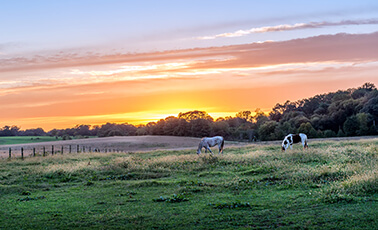Feeding the Average Horse
Aug 31, 2020

By Grey Parks, TFC Equine Specialist
Most articles and tips for feeding horses focus on the more complicated cases: metabolic horses, hard keepers, broodmares, high performance horses, etc. What about the average horse?
First, let’s define “the average horse”. The average horse is about 14.2 – 15.2 hands tall and weighs approximately 1,200 pounds. The average horse is ridden lightly (1-3 hours per week) or not at all and is 5 to 15 years old. This horse has no known metabolic or health disorders. What should we feed this type of horse?
For all horses, the foundation of the diet should be forage – pasture or hay. Horses are grazing animals and, in a natural setting, spend about 18 hours a day eating. Given the opportunity, most horses will consume roughly 2-2.5 percent of their body weight in forage dry matter per day. For our average 1,200-pound horse, this means about 24-30 pounds of forage, or roughly half of a typical small square bale of hay per day.
If the pasture or hay, in this scenario, is of moderate or better quality, it will most likely provide the average horse with plenty of energy (calories) and crude (overall) protein. The horse will easily maintain its body condition. However, even exceptional quality hay or pasture is unlikely to contain the precise balance of amino acids, minerals, and vitamins our horse requires for optimum health and performance. These nutrients must be provided, but too many more calories may make the horse fat. Don’t worry; TFC has just the product for “the average horse” scenario – Pinnacle Balancer (#336PE). This type horse needs only 1.5 pounds of Balancer per day to meet its amino acid, vitamin, and mineral needs. Don’t forget to also make plain salt, either loose or in block form, and plenty of fresh water available on a free-choice basis.
When it comes to feeding the average horse, “keep it simple” is the best rule of thumb. Pinnacle Balancer, along with free-choice access to water, plain salt, and forage, will meet this horse’s nutrient requirements.
For more information on all things equine please reach out to your local Co-op!
Most articles and tips for feeding horses focus on the more complicated cases: metabolic horses, hard keepers, broodmares, high performance horses, etc. What about the average horse?
First, let’s define “the average horse”. The average horse is about 14.2 – 15.2 hands tall and weighs approximately 1,200 pounds. The average horse is ridden lightly (1-3 hours per week) or not at all and is 5 to 15 years old. This horse has no known metabolic or health disorders. What should we feed this type of horse?
For all horses, the foundation of the diet should be forage – pasture or hay. Horses are grazing animals and, in a natural setting, spend about 18 hours a day eating. Given the opportunity, most horses will consume roughly 2-2.5 percent of their body weight in forage dry matter per day. For our average 1,200-pound horse, this means about 24-30 pounds of forage, or roughly half of a typical small square bale of hay per day.
If the pasture or hay, in this scenario, is of moderate or better quality, it will most likely provide the average horse with plenty of energy (calories) and crude (overall) protein. The horse will easily maintain its body condition. However, even exceptional quality hay or pasture is unlikely to contain the precise balance of amino acids, minerals, and vitamins our horse requires for optimum health and performance. These nutrients must be provided, but too many more calories may make the horse fat. Don’t worry; TFC has just the product for “the average horse” scenario – Pinnacle Balancer (#336PE). This type horse needs only 1.5 pounds of Balancer per day to meet its amino acid, vitamin, and mineral needs. Don’t forget to also make plain salt, either loose or in block form, and plenty of fresh water available on a free-choice basis.
When it comes to feeding the average horse, “keep it simple” is the best rule of thumb. Pinnacle Balancer, along with free-choice access to water, plain salt, and forage, will meet this horse’s nutrient requirements.
For more information on all things equine please reach out to your local Co-op!